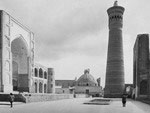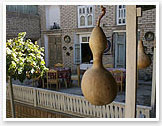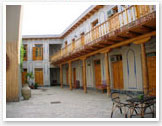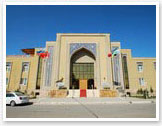 |
| source: dic.academic.ru |
Bukhara is one the cities, which history goes back to the uncertainty. First written records were made by Chinese travelers in the II century BC. Prior that period, information about the city or populated area was mentioned only verbally, in the legends. For example, by one of the legends, the Iranian prince Siyavush arrived to these lands, and married the daughter of King of Afrasiab, after he had fulfilled the task of the king to build the entire fortress on the only one bull's skin.
On the other hand, it was historically established, that Bukhara had many names, and there were many attempts to explain the name of the city. The Chinese called it Poo-Ho, or Noo Mi. There were variations of the current name: Bihara, Bukhar. Bukhar – from Chinese and Uighur meant "the place of idols”, and Bihar - in Sanskrit meant "the monastery". Therefore it is impossible to assert with confidence this or that particular version of the origin of settlement and its name.
Now the age of Bukhara is identified as 2500 years old, evidence of which is cultural layers reaching a depth of 20 meters.
Chronologically, the history of the city begins with the capture of this region by Persian king Cyrus in the VI century BC. The supremacy lasted for 3 centuries till the arrival of troops of Alexander of Macedon. By this time (329 BC) Bukhara was the city, the center of which became the Ark fortress. The Great Silk Road passed through the city, thanks to that there had already been more than 60 caravanserais here, in which caravans from China, India and other Eastern countries had the rest.
In the I century BC, Bukhara was the part of the Kushan Kingdom, then it was under the control of the State of Ephtalites, and in VI-VII centuries became the part of the Western Turkic Khanate.
In the beginning of VII century it was the crucial moment in the history of Bukhara – the city was captured by Arabs, who finally conquered almost the entire Central Asia. Arads began to inculcate Islam everywhere. But the local population rose in rebellion, which was called "Movement of people in white robes”, the leader of which was Hashim ibn Hakim (Mukanna). The rebellion was brutally suppressed, but Arabs fearing of further unrest transferred the local power to Bukhara aristocracy.
The IX century was the time of positive changes in the city – the Samanid Dynasty came to the power and made Bukhara the capital of their huge state. The city was growing, new mosques, bazaars and residential neighborhoods appeared. And the new fortress wall with 11 main gates was built around the city.
The X century was the epoch of advanced science and culture in Bukhara: leading scientists, poets, philosophers, artists, and many others worked in the city. Among them there was the outstanding person - Abu Ali ibn Sina, who is called as Avicenna in Europe. Along with him the poet Rudaki, Dakiki, Narshakhi, Tabari worked here.
In XI-XII centuries, Bukhara was conquered by nomadic tribes - at first it was ruled by the Karakhanids, and then they were replaced by Kara-Chinese. This period was one of the worst in the history of Bukhara, and the population of the city being unable to bear this pressure, raised the major revolt, led by Malik Sanjar. The neighboring state of Khorezm Shahs taking the opportunity of this moment suppressed the revolt and established its power here.
However, soon there were even worse times: the city was captured by the troops of Genghis Khan. The city was plundered and the people were taken away to Mongolia, into slavery. But the city had been gradually recovered, and when Marco Polo visited it, he described Bukhara as the city of much greatness. The power of Mongols started to weaken and in 1370 the city moved under the rule of the State of Timurid. The city lost its political status as the capital was Samarkand, but during the reign of Ulugbek the major cultural center of Asia was formed here.
In 1506 Bukhara was captured by the Shaybanids. For 50 years of their reign they had moved the capital here from Samarkand, and formed the state, which was called the Khanate of Bukhara. This name persisted for nearly 4 centuries. Dynasties changed each other, the flourishing of the city was replaced by the decline. It was the time of great changes.
In the second half of the XIX century, Russia began its expansion into Central Asia, during which the Khanate of Bukhara was conquered. However, the Emir of Bukhara had achieved the truce, and the Russian Empire established the protectorate over the Khanate. The city received the new development, the railway was built, and the constant inflow of entrepreneurs and workers from Russia began.
During the Russian revolutions, people of Bukhara rose in their revolution, as the result of which was the deposition of the Emir of Bukhara, and the establishment of Bukharan People's Soviet Republic. In 1924, the Uzbek SSR was created, and Bukhara joined it, as the administrative center of Bukhara region.
Today after declaration of the Independence of Uzbekistan, Bukhara remains the center of Bukhara region in the Republic of Uzbekistan. The city lost the status of large trade and cultural center and became one of the leading tourist centers of the country.







